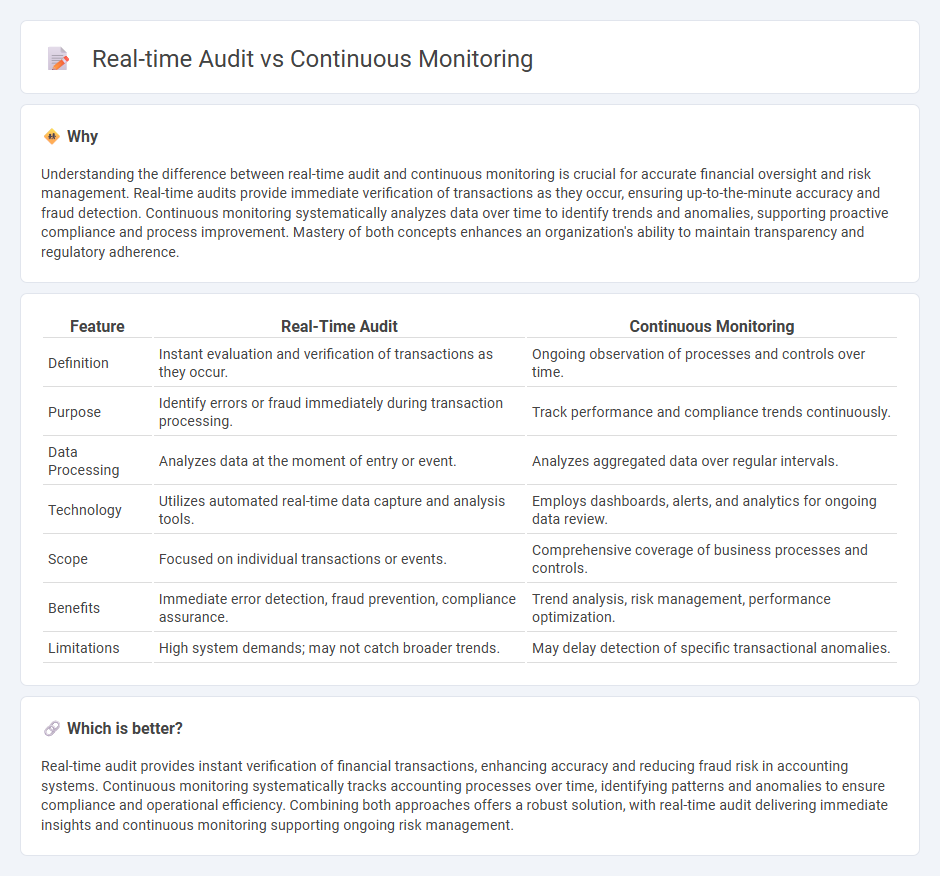
Real-time audit leverages advanced technology to analyze financial data instantly, ensuring immediate detection of discrepancies and compliance issues. Continuous monitoring systematically tracks transactions and controls over time to identify trends, risks, and potential fraud before they escalate. Explore how integrating these approaches enhances financial accuracy and organizational transparency.
Why it is important
Understanding the difference between real-time audit and continuous monitoring is crucial for accurate financial oversight and risk management. Real-time audits provide immediate verification of transactions as they occur, ensuring up-to-the-minute accuracy and fraud detection. Continuous monitoring systematically analyzes data over time to identify trends and anomalies, supporting proactive compliance and process improvement. Mastery of both concepts enhances an organization's ability to maintain transparency and regulatory adherence.
Comparison Table
| Feature | Real-Time Audit | Continuous Monitoring |
|---|---|---|
| Definition | Instant evaluation and verification of transactions as they occur. | Ongoing observation of processes and controls over time. |
| Purpose | Identify errors or fraud immediately during transaction processing. | Track performance and compliance trends continuously. |
| Data Processing | Analyzes data at the moment of entry or event. | Analyzes aggregated data over regular intervals. |
| Technology | Utilizes automated real-time data capture and analysis tools. | Employs dashboards, alerts, and analytics for ongoing data review. |
| Scope | Focused on individual transactions or events. | Comprehensive coverage of business processes and controls. |
| Benefits | Immediate error detection, fraud prevention, compliance assurance. | Trend analysis, risk management, performance optimization. |
| Limitations | High system demands; may not catch broader trends. | May delay detection of specific transactional anomalies. |
Which is better?
Real-time audit provides instant verification of financial transactions, enhancing accuracy and reducing fraud risk in accounting systems. Continuous monitoring systematically tracks accounting processes over time, identifying patterns and anomalies to ensure compliance and operational efficiency. Combining both approaches offers a robust solution, with real-time audit delivering immediate insights and continuous monitoring supporting ongoing risk management.
Connection
Real-time audit and continuous monitoring are interconnected through their shared use of automated data analytics to enhance financial oversight and risk management. Continuous monitoring provides ongoing surveillance of transactions and controls, enabling real-time audits to identify discrepancies and potential fraud instantly. This integration improves accuracy and compliance by allowing organizations to detect and address issues as they occur.
Key Terms
Automation
Continuous monitoring employs automated tools to collect and analyze data at regular intervals, enabling early detection of anomalies without manual intervention. Real-time audit integrates advanced automation to provide instant insights and alerts during ongoing transactions, enhancing immediate risk management and compliance. Discover how automation transforms audit efficiency and accuracy by learning more about these technologies.
Data Streams
Continuous monitoring involves ongoing analysis of data streams to detect anomalies and compliance issues over time, ensuring persistent oversight. Real-time audit processes data streams instantly to identify and respond to irregularities or risks as they occur, enabling immediate corrective actions. Explore detailed insights on how continuous monitoring and real-time audits leverage data streams to enhance organizational security and compliance.
Exception Reporting
Continuous monitoring integrates automated exception reporting to identify anomalies in financial transactions over time, enhancing ongoing risk assessment. Real-time audit emphasizes immediate detection and notification of exceptions during transaction processing, enabling swift corrective actions. Explore detailed comparisons to optimize exception reporting strategies for your audit framework.
Source and External Links
The Continuous Monitoring Ultimate Guide - This guide explores the concept of continuous monitoring, focusing on its implementation and how it differs from traditional monitoring by providing real-time threat detection and response.
What is Continuous Monitoring? - This article defines continuous monitoring as a systematic process that uses automated tools to monitor performance and security, helping organizations detect and respond to threats quickly.
What Is Continuous Monitoring? - This resource explains continuous monitoring as an ongoing approach to monitoring IT systems and networks for security threats, performance issues, or application layer vulnerabilities.
 dowidth.com
dowidth.com